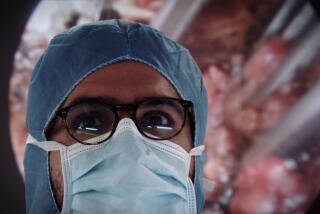Baedeker for the Bowels
- Share via
To psychoanalysts, it is the first gift a child presents to his adoring parents; to children, it is the stuff of endlessly repeated jokes; to Pauline Christians, it is the very essence of worldliness; to Ralph Lewin, it is the subject of a beguiling little compendium of arcane information. It goes by many names: feces, dung, turd, crap, stool, droppings, excrement, crottels, scats, manure, mutes, spraints, fumets to name only a few. And it is of course omnipresent in animal life, though it is not something of which adults readily speak, nor is it much appreciated by the average Joe who, if he is healthy, produces it on a daily basis, only to flush it into the bowels of the sewerage system with nary a thought about its chemical composition or its ecological function or its symbolic role in human community.
Lewin, a professor of marine biology at UC San Diego, is a connoisseur of all things fecal. With “Merde,” he seeks to unveil the mysteries and wonders of animal stool, by way of enshrining a new academic discipline, which he calls comparative coprology.
Lewin’s book is crammed full of fun facts to know and tell about excrement. We learn that rabbits can excrete 500 pellets a day, that dinoflagellates in plankton manufacture boli as big as themselves, that elephants every few hours produce a rumbling turd of six to 30 kilos. We learn that feces come in a veritable rainbow of colors: red when humans eat beets; blue when bears ingest blueberries; green when hyena droppings are fresh; white when they are aged; purple when produced by octopuses that have dined on squid; and black and tar-like when squirted out by the vampire bat, whose diet consists entirely of blood. We learn that healthy human turds are 80% water as compared to the 50% and 90% racked up by constipation and diarrhea respectively. We learn of such apparently bizarre animal practices as refection, the reingestion of one’s own scat, and transfection, the feeding of it to one’s young. Rabbits, for example, are known to eat their own stool (though whether they are able to chow down on 500 pellets at a sitting remains unclear), as they lack long intestines and need to send the grasses on which they feed through their guts twice in order to break them down into the nutrients necessary for rabbit health. Beavers, squirrels, guinea pigs and chinchillas also engage in refection. Even more wonderful is the naked mole rat youngster who, when hungry, manages to feed directly from the anus of an adult mole rat who happens to be passing by in an underground burrow. Similarly, newborn koalas have to dine on their mother’s excreta in order to receive the essential bacteria that will allow them to digest the eucalyptus leaves that will be their primary source of vitamins for years to come. Alas, I shall never gaze upon the koala, cuddly mascot of Qantas Airlines, with an innocent eye again.
Lewin is also quite informative when it comes to matters associated with fecal production. “The sound of intestinal gas bubbles burbling their way down and out--in apparent defiance of the laws of gravity--is called ‘borborygmus,’ ” writes Lewin, only to then suggest that “it might also be known as ‘colophonics.’ ” Cows, as it turns out, are highly borborygmic, though their gas does not pass through the anus but rather through the mouth. Indeed, cows produce 60 million tons of methane gas a year from their ruminative digestive practices and burp it into the atmosphere, producing more than 15% of the world’s methane each year. Though humans have yet to figure out a way of harnessing the enormous potential of bovine belching, they have used dung for centuries as a source of energy. In India, cow dung provides up to 25% of the nation’s fuel, equal to 35 million tons of coal per annum. Roald Dahl wrote that people on a small island off the coast of Norway enjoy a pipe of goat dung now and again, though I suspect this may well have been a notion Dahl cooked up for a children’s book he never got around to writing. And of course, animal excrement of all kinds has been used as fertilizer since time immemorial and is essential to vegetable production, though when fertilizer of human fabrication is employed, the night soil men who collect and distribute it are usually considered the lowest of the low in their societies. In India, for example, the Bhanji Untouchables, assigned to such a task, are so untouchable that even other pariahs will not consort with them. Regarding abstergents, I was glad to learn that medievals used hay balls and sticks to clean themselves, while Rabelais’ Gargantua employed a live goose to do his dirty work, though I was a bit miffed by Lewin’s neglect of the Persian aftabeh, a sort of pitcher that allows one to dribble water down one’s back into the furrow between the buttocks and so avoid the application of toilet paper, which cultured Iranians believe only makes matters worse by smearing.
*
“Merde” is somewhat difficult to digest, not because of the subject matter, which Lewin treats with admirable aplomb, but because it includes so many facts that one is hard pressed to remember them. Lewin’s style is urbane, and he has an excellent ear for the cadences of language, though at times his very breeziness leads him to zip through details that would seem to demand more explication. Take for example the following: “[N]eurologists have discovered that the whole business of digging, squatting, defecating, and scraping is a reflex that can be stimulated electrically even in an animal that is technically dead.” Now I can imagine an animal carcass being induced to defecate by application of electrical current, and I can even conjure up a kind of zombie animal digging, but I draw the line at scraping when it comes to dead beasts.
“Merde” is best when it treats purely scientific matters, for Lewin is immensely knowledgeable about his subject and is able to observe and describe his raw data in admirable detail. When the book turns to matters cultural, it is far less impressive, as Lewin avoids the reams of psychological, anthropological, mythological and literary theory that have accrued to the subject of feces. For example, toward the outset of the book, he mentions in passing that St. Paul vilified all things of the world as stercoro, yet he never engages a thorough discussion of what might be called the excremental vision of the world, highlights of which in the Western literary tradition would be St. Paul’s Epistles, St. Jerome’s “Against Jovinanus,” Swift’s “Gulliver’s Travels,” the gravedigger scene in Hamlet and the whole oeuvre of the Marquis de Sade. And though it is fascinating to learn that a prototype toilet seat dating from 2700 BC was excavated in Egypt and that the flush toilet was designed not by the famous Thomas Crapper (who installed sumptuous facilities in Sandringham Castle in the late 19th century) but by Sir John Harrington in the court of Elizabeth I, Lewin misses a great socio-cultural opportunity in his discussion of the history of toilets. For instance, he claims that the design of the shelf toilet in Germany, which allows one to produce a scat that sits proudly on a porcelain shelf unencumbered by the refractory distortions of water, is the result of a desire to reduce water consumption. As anyone who has spent time in Germany knows, the shelf is surely more culturally significant than Lewin lets on, as are the rituals surrounding its proper maintenance, as it affords the opportunity of inspecting a naked turd with the naked eye and thus of making various determinations about one’s physical and psychic health. That Germans are attached to their shelves is no secret; I for one was once ejected from a Frankfurt apartment as a result of my inability to keep the shelf in a properly sauber state.
So what to make of the discipline of comparative coprology? If Lewin’s book is any indication, the discipline is still in its formative state, as the sub-disciplines on which it must draw for intellectual nourishment are merely adumbrated rather than worked out in this slim but highly engaging volume. Lewin’s book is best read as a kind of Baedeker for the bowels, and the ride it offers is both jaunty and informative, as the author has done his homework. As its subtitle would indicate, “Merde” is indeed composed of a series of excursions, but at the end of the trip we do not really arrive at a fundamentally different understanding of the mysterious stuff we manufacture each day, the materia ejecta of our walk through the world.






